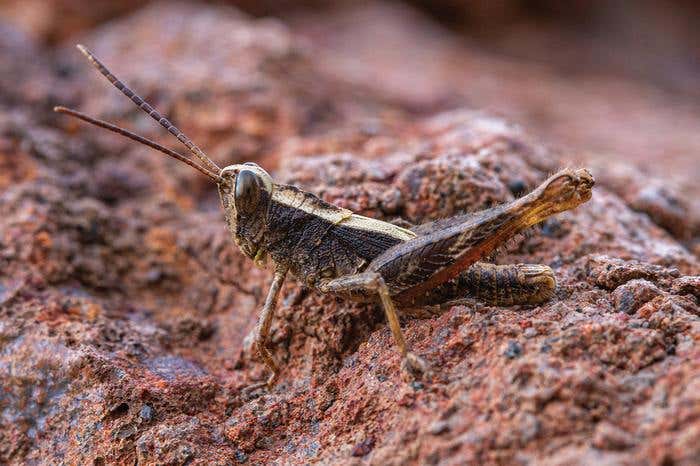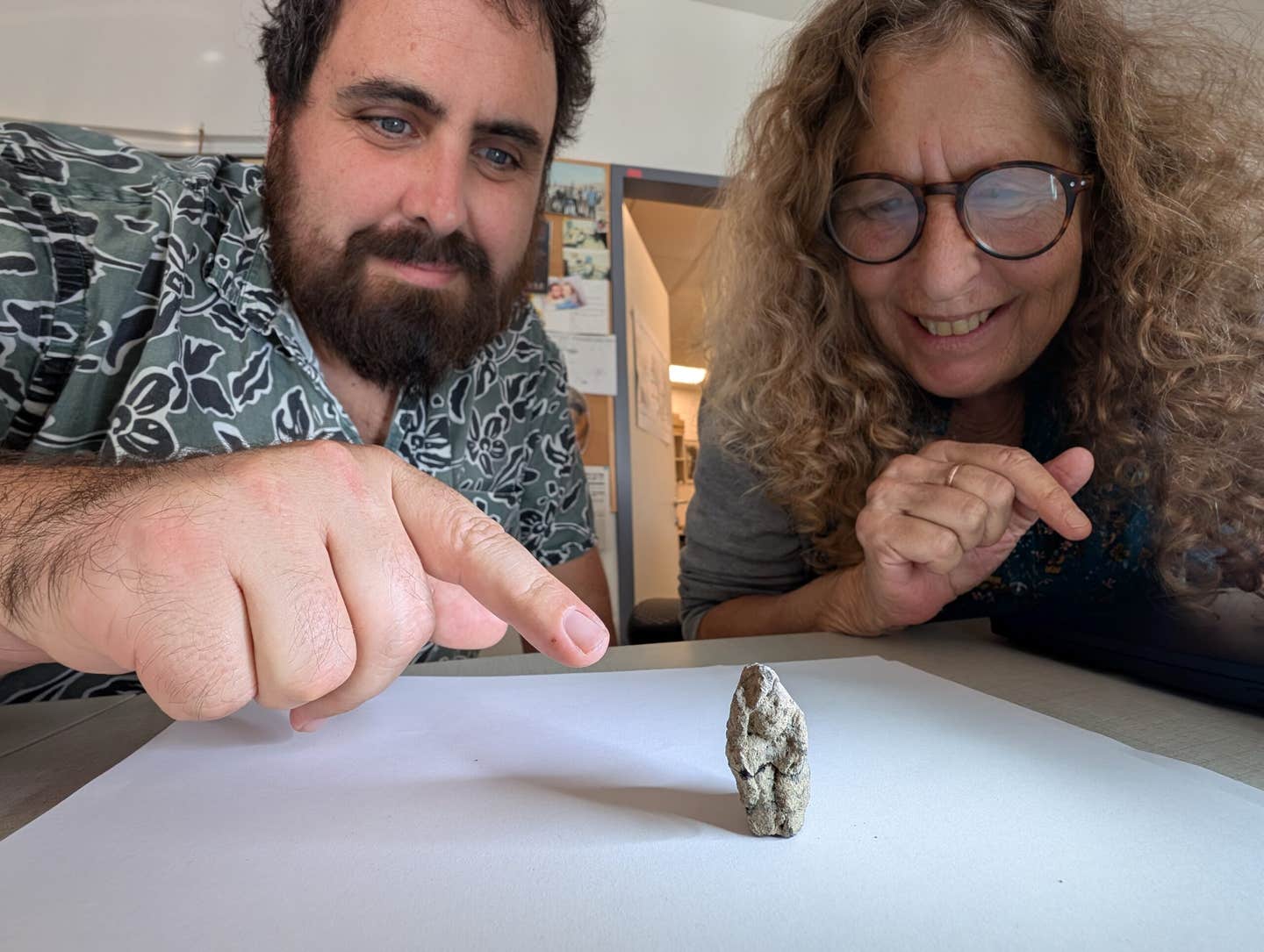Rare grasshopper species rediscovered after being lost for over 40 years
A rare grasshopper thought extinct since 1980 has been rediscovered on a remote island, offering scientists new hope for conservation.

The Monte Gordo Grasshopper, once declared extinct, has been found alive after 40 years on São Nicolau island. (CREDIT: Rob Felix)
In 1980, a single male grasshopper was collected on the island of São Nicolau in Cape Verde. No one knew then that this moment would mark the only sighting of a species that would soon be considered lost forever.
The insect, Eyprepocprifas insularis, or the Monte Gordo Grasshopper, was described by scientists working on a French research program studying locusts in the Sahel. Despite returning to the island several times over the next few years, the team never saw the grasshopper again. With no further sightings and no preserved population, scientist Dr. Michel Lecoq officially declared it extinct in 1996.
But nature had other plans.
Over four decades later, in January 2023, two biologists, Rob Felix and Annelies Jacobs, decided to take a vacation on São Nicolau. As field researchers, they were always on the lookout for unique wildlife. Before their trip, they learned about the Monte Gordo Grasshopper. Even though it was considered extinct, they hoped there might be a chance to see it again.
On their very first night, while hiking to observe a rare seabird colony, Rob saw something unusual. “I stumbled upon a grasshopper sitting on the path. When I looked closer in the torch's light, I immediately recognized its unique appearance,” he recalled. “I shouted out loud: it's Eyprepocprifas! To my surprise, correct at once because it's not the most easily pronounceable genus name.”
In the days that followed, the pair discovered more specimens of the rare grasshopper within the Monte Gordo Natural Park and surrounding areas.
The rediscovery was later confirmed and detailed in a paper published in the Journal of Orthoptera Research. It marks a major event in conservation biology.
A Living Fossil on Volcanic Ground
The Monte Gordo Grasshopper is no ordinary insect. It is what scientists call a “living fossil,” a creature that has changed very little over millions of years. These animals often have few or no close living relatives. They survive in isolated environments where evolution takes a slower path.
Related Stories
In this case, the grasshopper is endemic to São Nicolau, meaning it lives nowhere else on Earth. The island itself has a rich volcanic history and is estimated to have formed around five million years ago.
The Monte Gordo region, where the grasshopper was found, sits at the highest point on the island, with its peak reaching over 1,300 meters above sea level. The natural park covers nearly 1,000 hectares and contains a humid mountain ecosystem that has remained somewhat intact despite centuries of human impact.
Cape Verde lies about 600 kilometers west of Africa in the Atlantic Ocean. It includes ten main islands, all formed by volcanic activity. The western islands, including São Nicolau, have steep mountains and deep valleys, shaped over millions of years by erosion and tectonic activity. These conditions have created unique environments where rare species like E. insularis can survive—hidden from the modern world.
A Harsh, Isolated Habitat
The climate on São Nicolau plays a big role in the grasshopper’s survival. Daytime temperatures hover around 22°C in February and rise to about 27°C in September. But what matters most isn’t the heat—it’s the moisture.
Rain is rare, with dry spells that can last years. In the lowlands, rainfall can be as low as 80 millimeters a year, while the highlands may get over 1,600 millimeters. Much of the water comes from fog that forms when moist trade winds blow over the mountains. This fog is essential for the survival of the island’s plant and animal life, providing a steady but limited source of moisture.
Vegetation in Monte Gordo is a mix of native and introduced species. Before humans arrived, the area likely had dense scrublands full of native plants like Euphorbia tuckeyana and Dracaena draco caboverdeana. Today, many of these plants survive only in scattered patches. Large parts of the park are now covered by trees like pine, eucalyptus, and cypress—species introduced in the 20th century for reforestation.
Even so, Monte Gordo remains one of the last strongholds for many of the island’s native species. It is home to several reptiles and insects found nowhere else in the world, including three unique lizards and two rare beetles.
But survival here is not easy. Strong winds from the African mainland often bring in new plant and insect species, and droughts are common. Despite these challenges, E. insularis has endured.
“The rediscovery of the only endemic brachypterous (short-winged) grasshopper, Eyprepocprifas insularis, on São Nicolau… provides significant insight into the island’s ecological and evolutionary history,” the researchers wrote.
A Second Chance for Conservation
When only one insect is ever found and none are seen again for over 40 years, extinction seems like a safe conclusion. But the Monte Gordo Grasshopper tells a different story.
Its rediscovery gives scientists a rare opportunity. For the first time, researchers were able to observe multiple individuals in the wild and describe the female of the species. The new study also provides a clearer picture of where the grasshopper lives, what its habitat looks like, and how it might be affected by humans.
Even though it has been found again, the insect still faces danger. Its range appears to be limited to a small section of São Nicolau. If anything were to happen to this habitat—through deforestation, drought, or development—the species could vanish for good.
“Now that it has been found again, we have the opportunity to take steps to protect this unique species and its habitat,” the researchers wrote. That effort includes proposing the species for listing on the International Union for Conservation of Nature (IUCN) Red List, a global registry of endangered species.
Official recognition could help drive future conservation efforts. Local authorities could restrict damaging activities in Monte Gordo and raise awareness about the fragile ecosystem. With careful monitoring and protection, scientists hope the grasshopper can be preserved for generations to come.
A Glimpse Into Earth’s Hidden Past
The Monte Gordo Grasshopper is more than just a rare insect. Its discovery opens a window into how life adapts and survives in isolation. It shows how ancient species can quietly endure in remote places, waiting to be seen again.
It also reminds us of the power of curiosity and hope. Two scientists, motivated by a distant possibility, stumbled upon a species long thought gone. What started as a casual walk turned into one of the most exciting rediscoveries in recent entomological history.
Sometimes, all it takes to rewrite the story of extinction is a flashlight, a keen eye, and the willingness to believe that life finds a way.
Note: The article above provided above by The Brighter Side of News.
Like these kind of feel good stories? Get The Brighter Side of News' newsletter.



